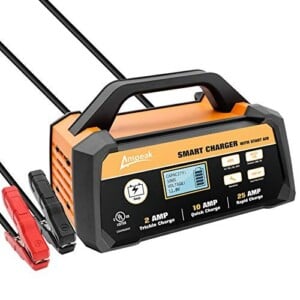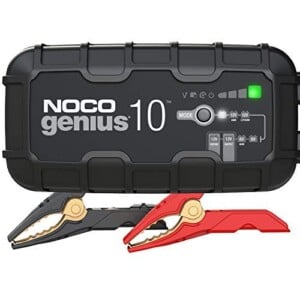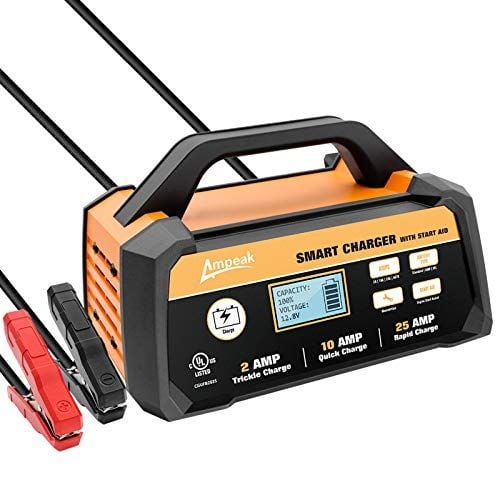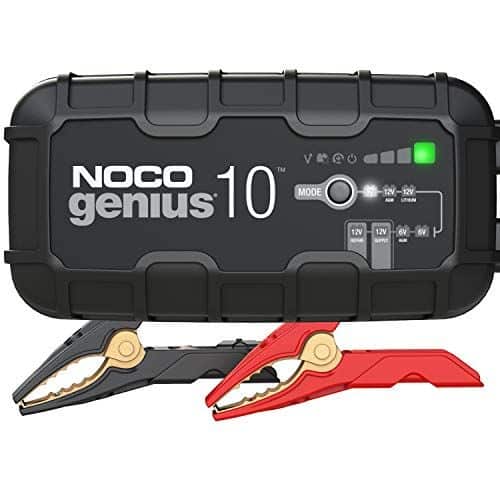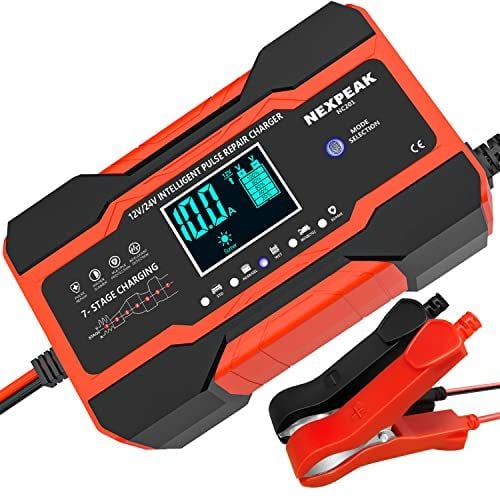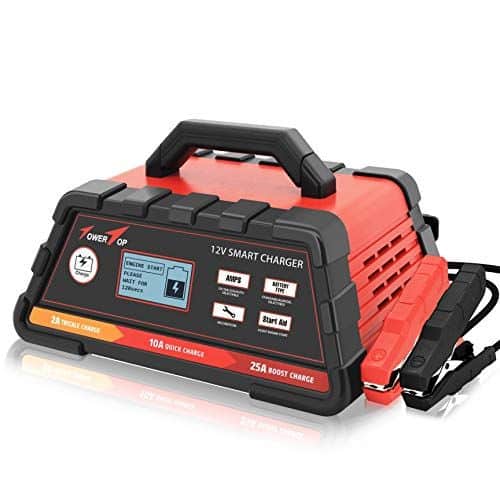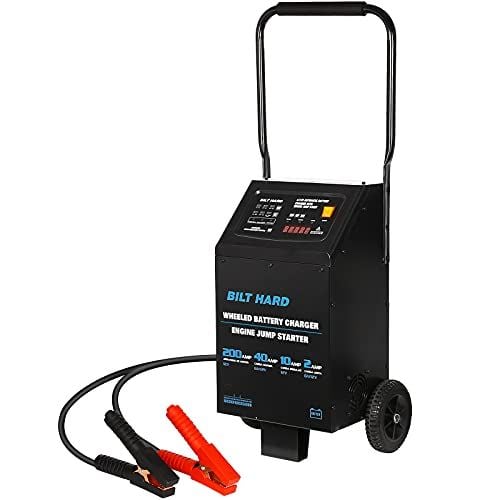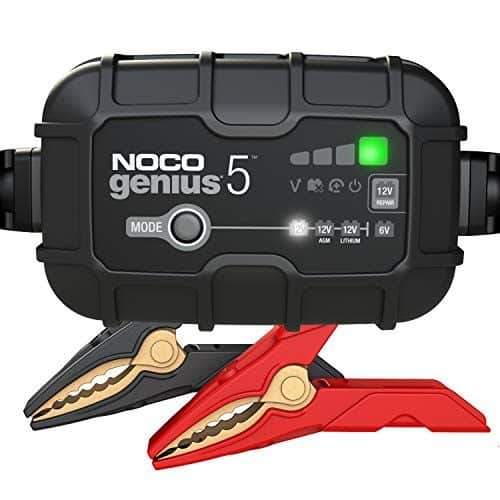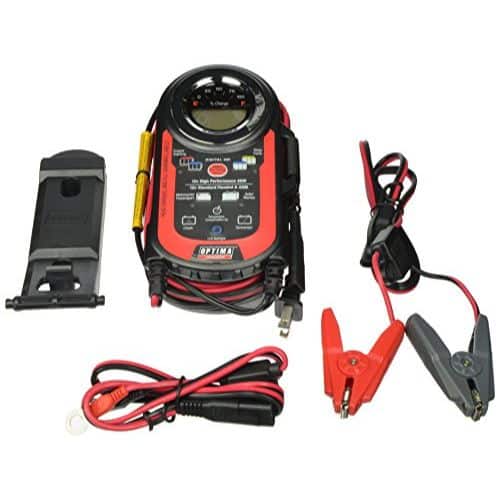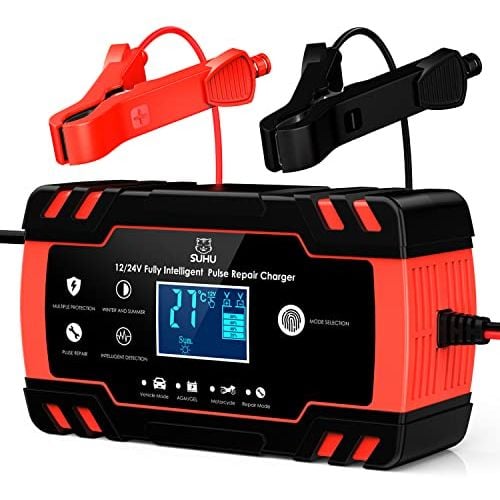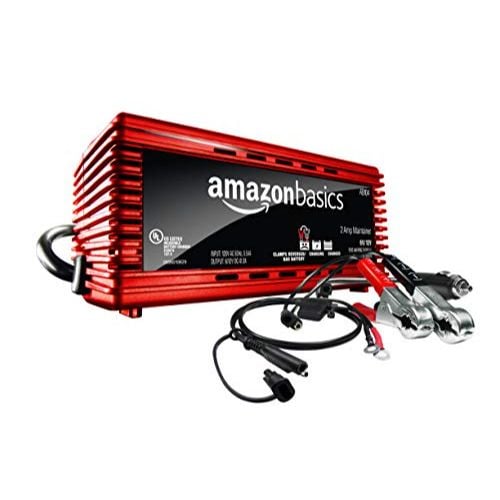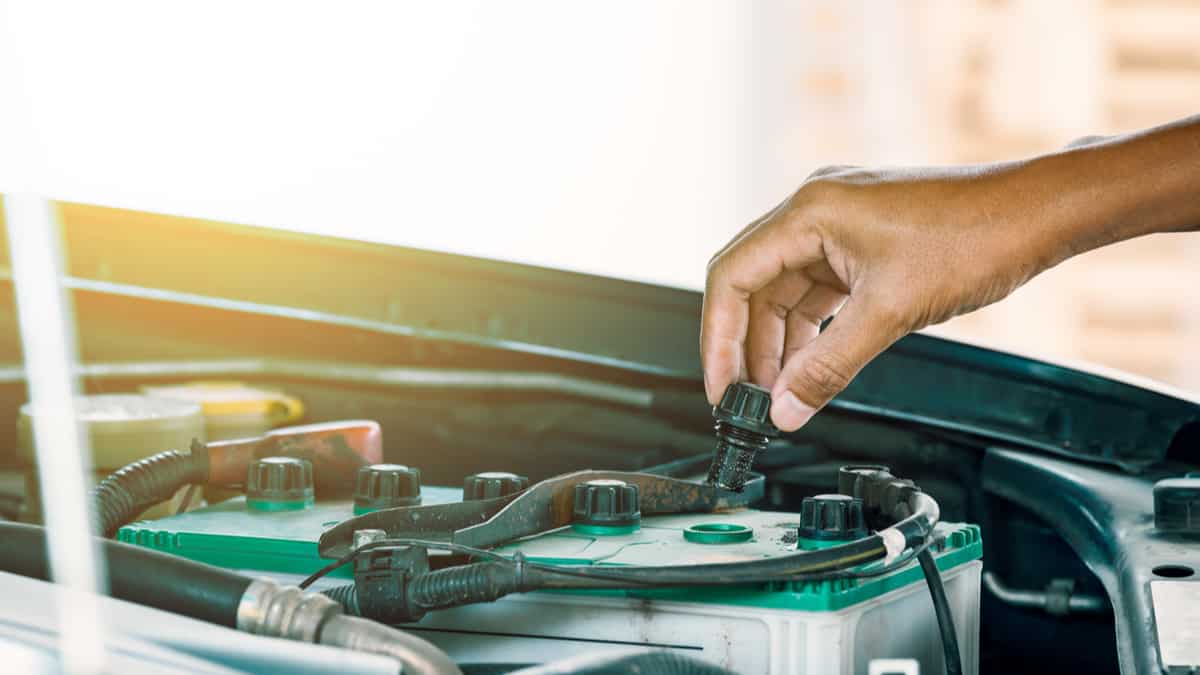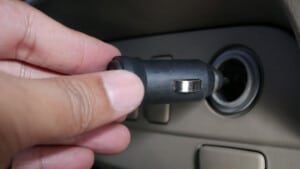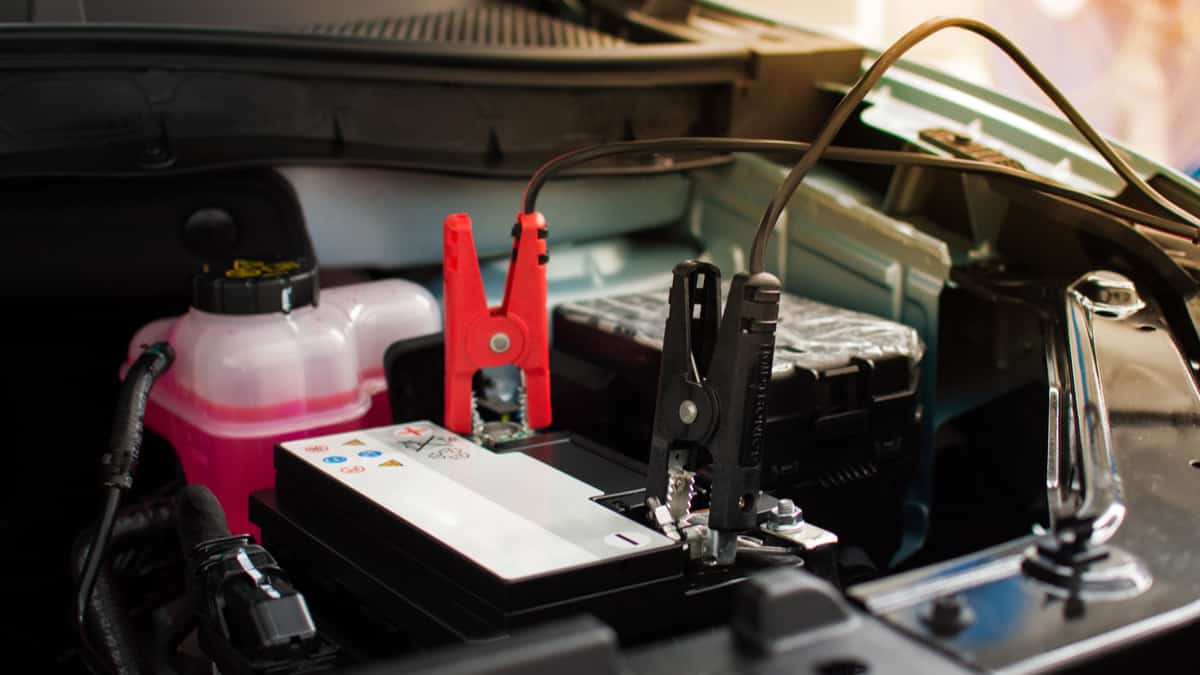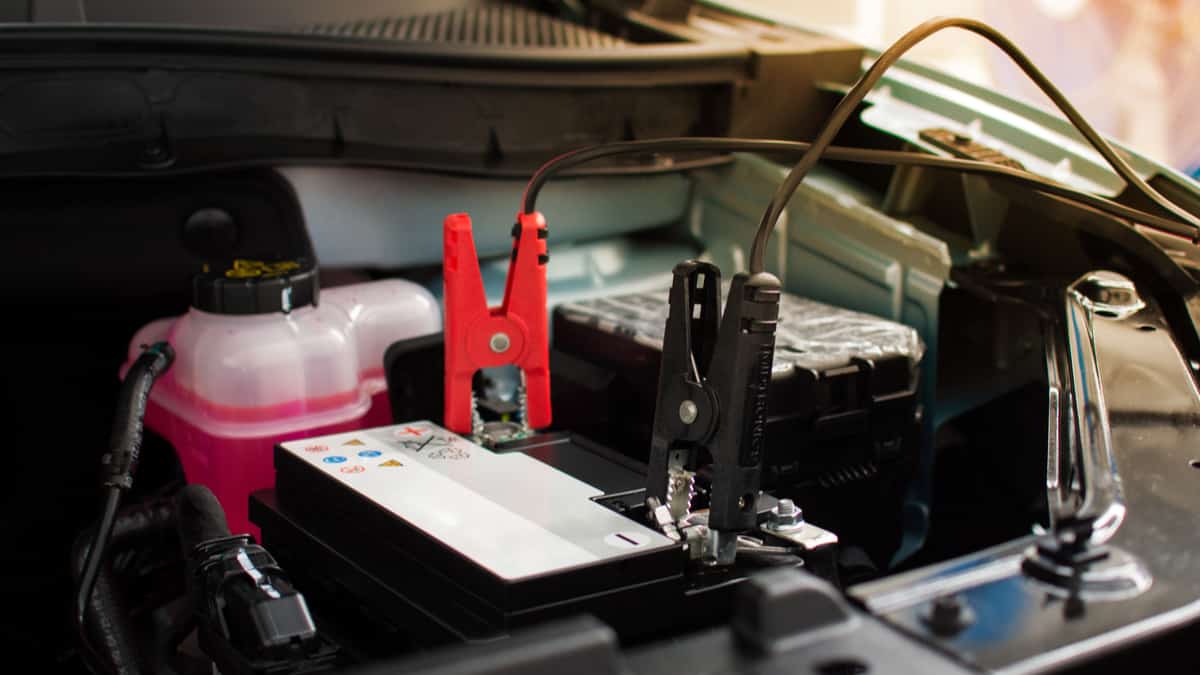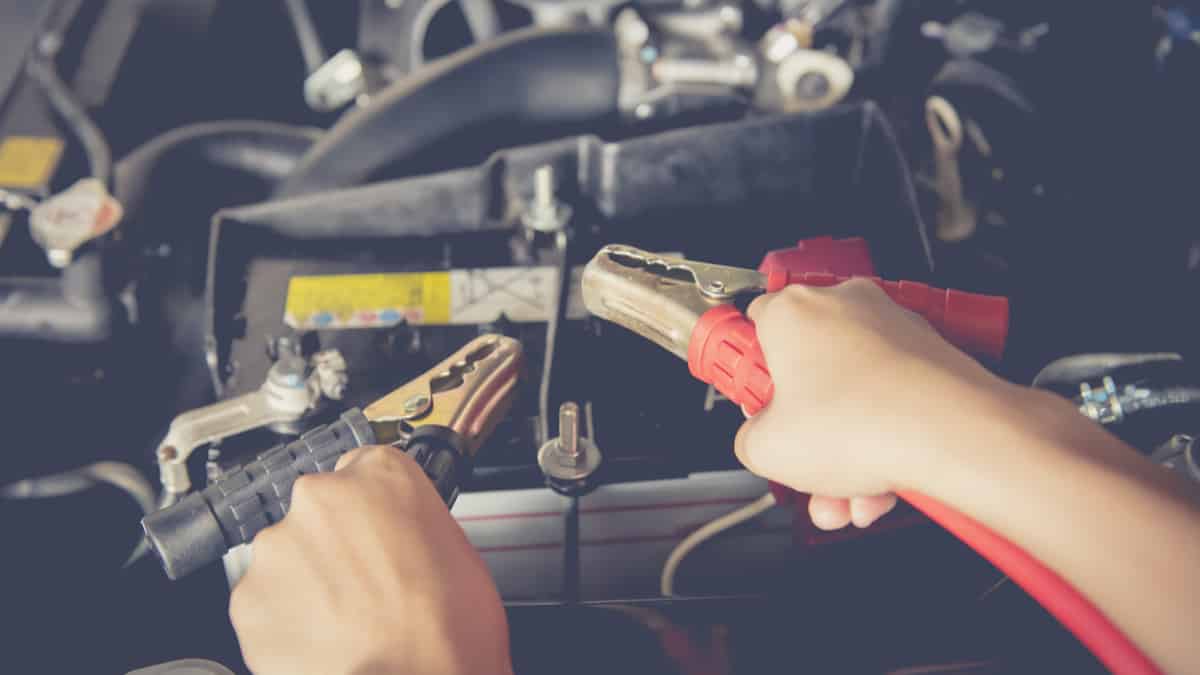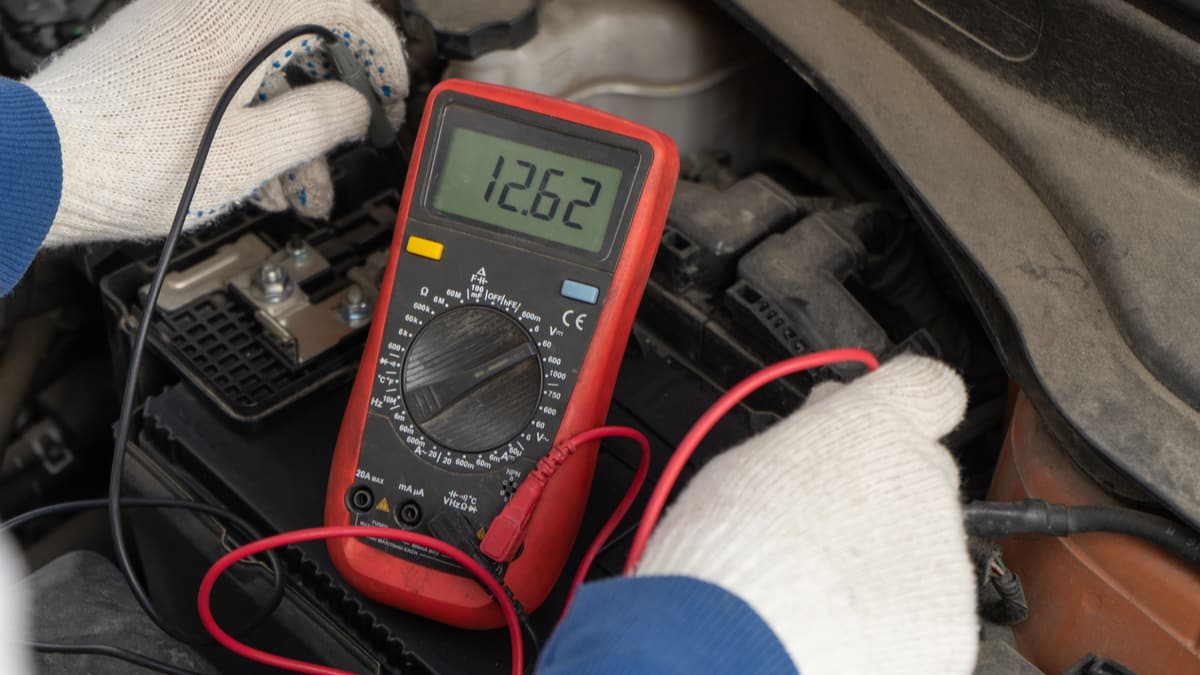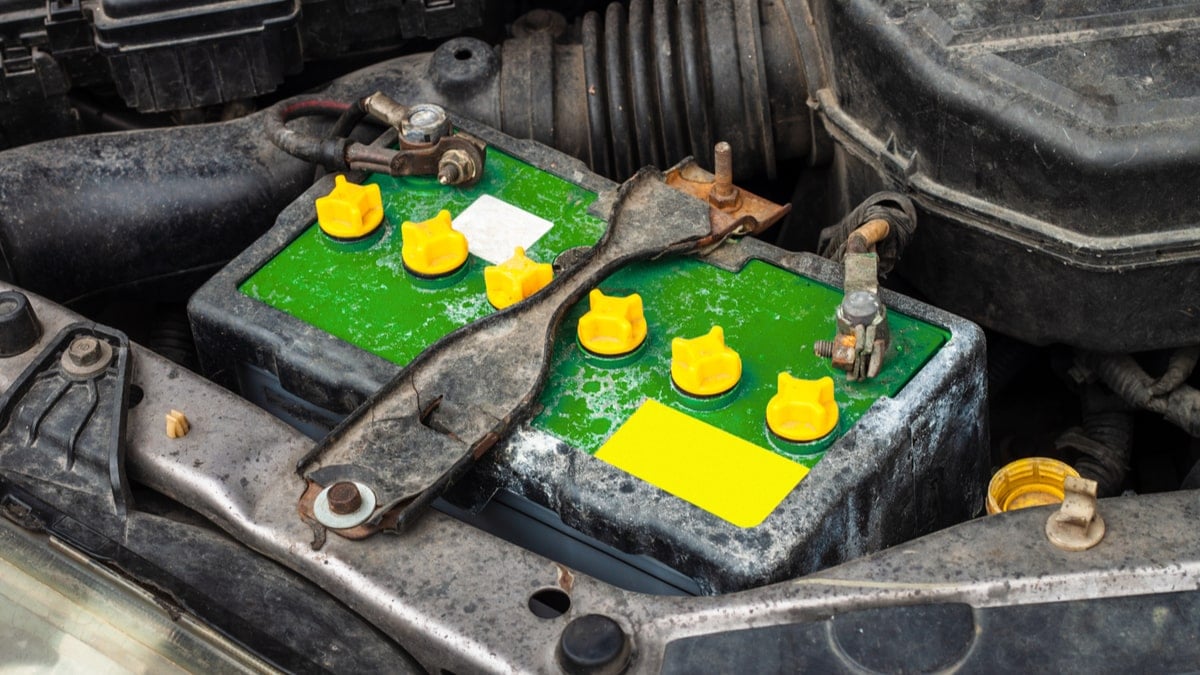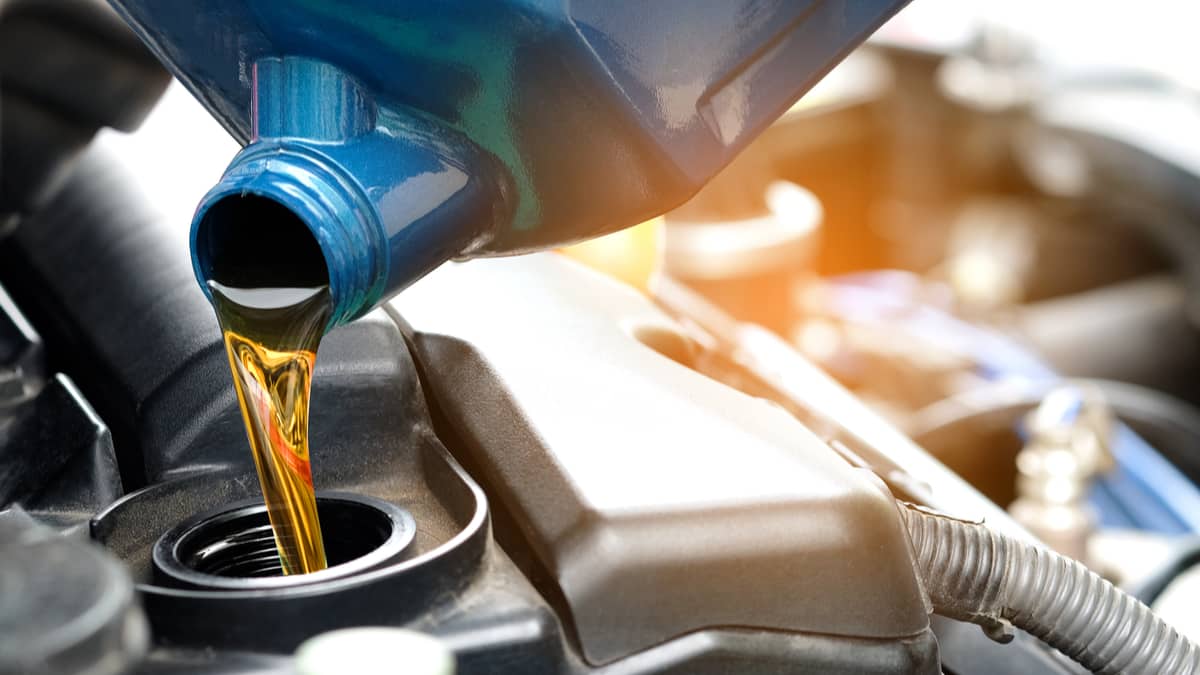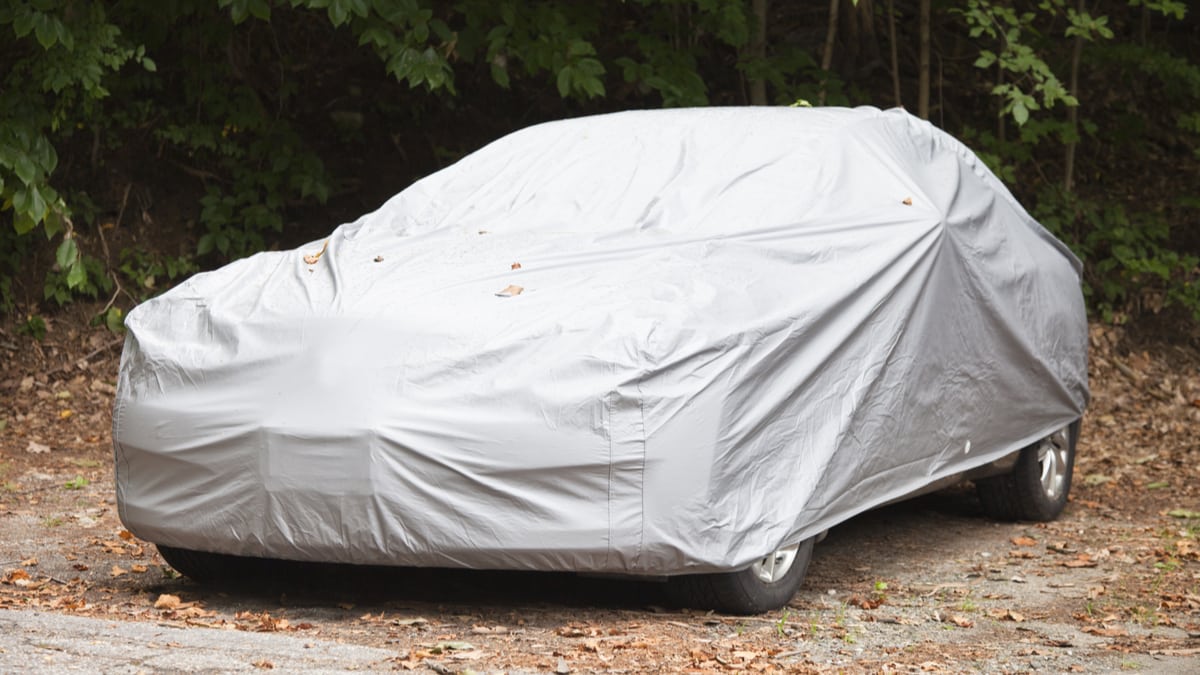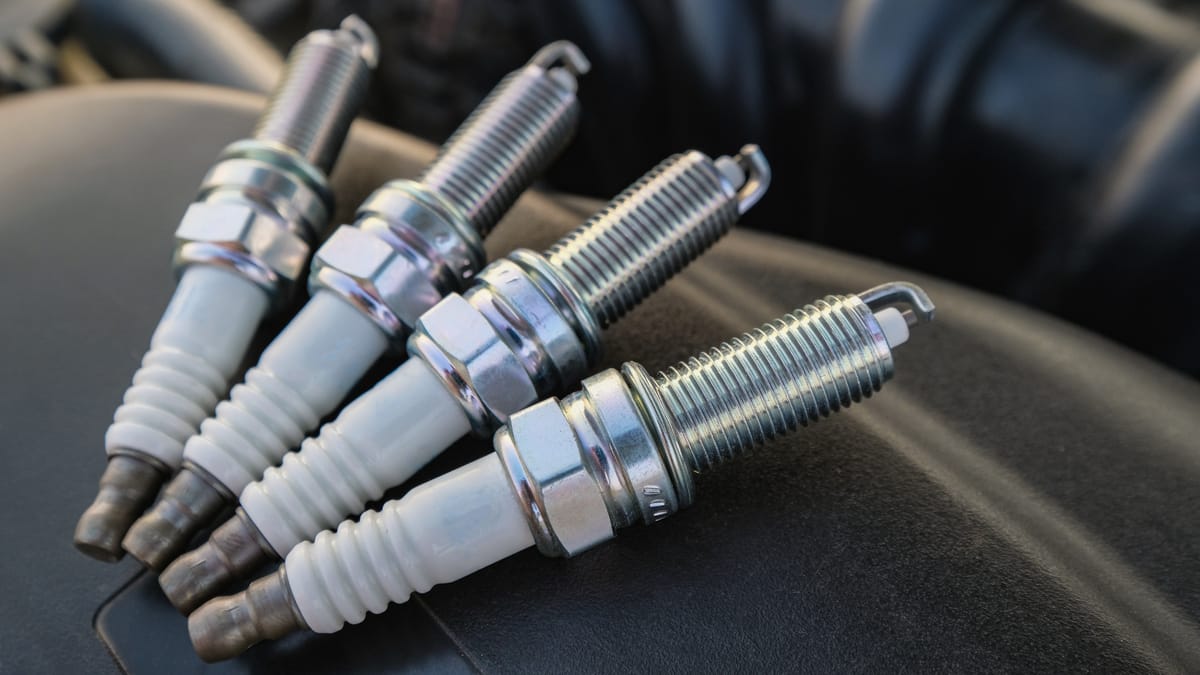The last thing you want to deal with when you head out to your car is a dead battery, and while a jump start is nice, that usually doesn’t get your vehicle’s battery back to a full charge.
Taking your battery to a shop can leave you stranded for hours, while a top-notch battery charger at home can bail you out. But while an excellent battery charger will get your battery charged and working like new, the wrong one is just a giant waste of time and money.
We’re tired of people wasting their time and money on car chargers that don’t work. That’s why we took the time to track down and review 10 of the best car battery chargers. Any of these car chargers will get your vehicle back on the road in no time.
The Best Car Battery Chargers
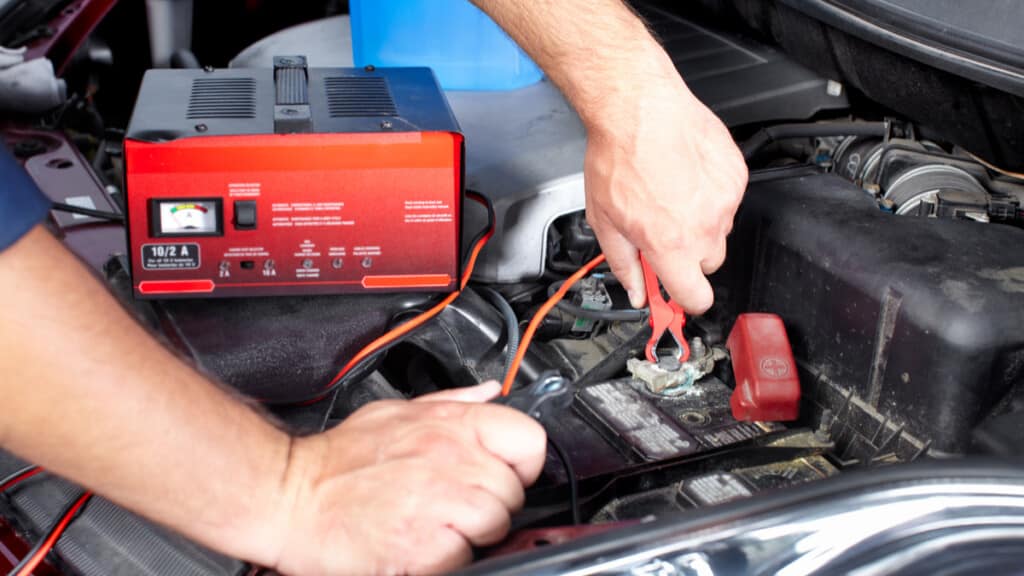
- Ampeak Smart – Best Car Battery Charger Overall
- NOCO GENIUS10 Charger – Premium Choice
- NEXPEAK 10-Amp Battery Charger – Best Budget
- Tower Top Smart Charger
- BILT HARD Wheeled Battery Charger
- NOCO GENIUS5 6- & 12-Volt Charger
- Optima Digital 400 AGM Charger
- Outerman 12- & 24-Volt Charger
- SUHU Car Battery Charger
- Amazon Basics Battery Charger
1. Ampeak Smart – Best Car Battery Charger Overall
- Charging Amps – 2, 10, and 25
- Charging Volts – 12
If you’re looking for a top-notch battery charger for your garage, the Ampeak Smart Battery Charger is a great choice. Sure, it only has a 12-volt charging option, but if you’re just looking for a battery charger for your car, that’s all you need.
Even better, with three different charging amps you can cycle through, you charge your battery as fast as you need to. You can set up a trickle charge overnight, or you can quickly charge the battery at 25-amps if you need to get on the road quickly.
This charger works on AGM, lead-acid, and gel batteries, all while offering diagnostic tests and jump-start assists. If you opt to leave your battery on the charger overnight, you don’t need to worry about accidentally overcharging it because of the overcharging protection system.
Additionally, it has a smart detection system that helps you pick the perfect amperage for charging will keep your battery fully charged without overcharging it.
As another perk, this charger comes with an impressive 18-month warranty, if you have any problems with their charger for any reason, they’ll make it right.
And if you’re new to batteries or working in the dark, the reverse polarity protection will keep you from frying both your charged and battery if you hook it up backward.
Finally, this smart charger also can act as a jump starter for your car! With a simple to use start aid button using this charger as a jump starter is just as simple as charging the battery. No matter what you need a 12-volt car charger for, this Ampeak Smart Battery Charger can get the job done.
Pros
- Great mix of price and performance
- Three charging amps give you more options
- 18-month warranty
- Smart detection charging system
- Reverse polarity and overcharging protection
Cons
- Only works on 12-volt batteries
2. NOCO GENIUS10 Charger
- Charging Amps – 10
- Charging Volts – 6 and 12
The NOCO GENIUS10 might not look like much, but don’t let its small size fool you. This small charger packs a punch and has plenty of versatility. It can charge both 6-volt and 12-volt batteries, and it doesn’t matter if they’re AGM, lead-acid, marine, lithium-ion, or something else.
This small little charger automatically detects the type of battery you’re charging and adjusts the output accordingly. Not only that, but it runs a diagnostic check on the battery to check for excessive sulfation and acid stratification and enter a different charge mode to try and repair damage.
Additionally, this is a charger you can set up and leave. With overcharge protection, you don’t need to worry about blowing up batteries by leaving them on too long. This system accounts for different weather conditions and other environmental concerns, giving you more peace of mind.
While we wish that it had more amperage options than just a 10-amp, with all the extra feature NOCO built-in, that’s not a huge deal. Just don’t expect to charge a completely dead battery in an hour.
This charger will do more than just charge your battery – it can extend the overall service life. After a few batteries, this charger will pay for itself, so look at it as an investment instead of a purchase, which is something you need to keep in mind when you look at the higher price tag.
Finally, NOCO includes a 3-year warranty for this charger, which gives you even more protection. But while the warranty might only last three years, the charger should last far longer.
Pros
- Small and portable
- Works on both 6-volt and 12-volt batteries
- It has overcharge protection
- Works with all types of batteries – AGM, lead-acid, marine, etc…
- 3-year warranty
- Detects and attempts to repair sulfation and acid stratification
Cons
- More expensive option
- Only one charging amperage
3. NEXPEAK 10-Amp Battery Charger
- Charging Amps – 5 and 10
- Charging Volts – 12 and 24
Just because you don’t have a ton of money to spend on a battery charger doesn’t mean you can’t get one that gets the job one. The NEXPEAK 10-amp charger is an extremely affordable option that you can use to get your battery back on track.
But the price isn’t the only thing that this charger has going its way. It also can charge both 12-volt and 24-volt batteries. However, while there are two amperage options, you truly only get one choice.
That’s because the 10-amp option charges 12-volt batteries, while the 5-amp option charges 24-volt batteries. There’s no way to change it between the battery types.
Still, there are seven different charging steps with this charger, and the charger detects and swaps to each mode automatically throughout the charging process. This helps repair your battery and get it back to running like new.
Moreover, there are plenty of protective circuits throughout this charger, including overcurrent/overcharging protection, reverse polarity protection, short circuit protection, temperature compensation, and more.
Finally, it has an easy-to-read monitor that lets you know the current state of your battery and when you can take it off the charger.
But with all the perks this charger offers, it still is a budget charger. Nothing highlights this more than the fact that it won’t charge completely dead batteries – it won’t even try. It uses a voltage detection system to start charging, and there’s no way to override it.
Not only that, but this charger doesn’t work with lithium-ion batteries. While it works for different battery types besides lead-acid, you must manually cycle through each battery option to get to the right one. It’s not a huge deal, but there is the risk of making a mistake.
Pros
- Affordably priced
- Reverse polarity protection
- Overcurrent/overcharging protection
- Easy to read monitor
Cons
- Will not charge completely dead batteries fast
- Does not work with lithium-ion batteries
4. Tower Top Smart Charger
- Charging Amps – 2, 10, and 25
- Charging Volts – 12
We understand that garages can be messy and cluttered, and things happen. That’s why the Tower Top Smart Charger is such an excellent choice for those that don’t have a track record of keeping everything right where it belongs.
Whether it’s sliding around your trunk or clanging into things in your garage, the extra protective casing around the Tower Top Smart Charger helps protect it from damage. In addition to the rugged protective casing, this charger offers three different charging amperages for different situations.
You can use the 2-amp option for a slow trickle charge, while the 25-amp option gives you the ability to quickly recharge a dead battery in just a few hours.
And when you’re really in a hurry, it has an engine start aid to help jump-start your car on cold mornings. Additionally, there are tons of protective circuits that include over-voltage protection, overheating prevention, and reverse polarity protection.
With this charger, the chances of damaging your battery, the charger, or yourself are extremely slim. This charger works with GEL, AGM, and lead-acid batteries, which is a huge perk if you have multiple vehicles with different batteries.
Moreover, the auto-detection feature ensures your battery gets an optimal charge without the need to put in a ton of different inputs. Even better, the easy-to-see and read LCD screen lets you know your battery’s current status and what’s going on.
So, while this might be a slightly more expensive option, when you factor in everything you’re getting and the extra protective casing, you’re really getting a great deal.
Pros
- It has an engine start aid for busy mornings
- Overvoltage, overheat, and reverse polarity protection circuits
- Works for GEL, AGM, and lead-acid batteries
- Auto-detection features give your battery an optimal charge
- Extremely durable casing
Cons
- Slightly more expensive option
5. BILT HARD Wheeled Battery Charger
- Charging Amps – 2, 10, 40, and 200
- Charging Volts – 6 and 12
If you own a maintenance shop or do work out of your garage, you need a charger that offers you tons of versatility, and that’s precisely what you get with this BILT HARD battery charger. There are three different charging options at 2, 10, and 40 amps, and it even has a 200-amp jump-starting option.
The entire setup is fully automatic, so all you need to do is connect the battery and turn it on to get a fully charged battery. And since BILT HARD knows you’re busy in the shop, this charger has overheating and overcharging protection.
With this charger there’s no more forgetting to taking a battery off the charger and damaging a perfectly good battery. Another perk to this charger is that it reconditions the battery you’re charging, which means it can actually extend the remaining battery life!
This battery also has reverse polarity protection, so if you’re in a hurry and hook things back backward on accident, you won’t damage the battery or the charger. Even better for maintenance setups is the fact that this charger works for all types of batteries.
Not only does it work on typical 12-volt batteries, but if you’re working on bikes or something with a smaller six-volt battery, this charger can handle that too.
Whether the customer has an AGM, GEL, or regular lead-acid battery, this charger can handle it. However, there are two drawbacks to this charger. First, it’s a more expensive option. While it’s an acceptable cost for a repair shop, it is something you need to budget for.
Second, it’s a much larger option compared to the other chargers on our list. While it’s a standard size for a shop battery charger, there are much smaller portable options out there now.
Pros
- Plenty of charging options
- Fully automatic setup is easy to use
- Reverse polarity, overheating, and overcharging protection circuits
- It works with all kinds of batteries
- Reconditions battery
Cons
- More expensive option
- Pretty large to lug around
6. NOCO GENIUS5 6- & 12-Volt Charger
- Charging Amps – 5
- Charging Volts – 6 and 12
If you’re looking for a battery charger that works for both your automotive battery and the batteries on your smaller vehicles like ATV, motorcycles, and even lawnmowers, the NOCO GENISU5 is an outstanding choice.
The NOCO GENIUS5 is similar to the GENIUS10 in every way but one, the charging amperage. The GENIUS5 puts out 5-amps, while the GENIUS10 puts out 10-amps. Neither is a lightning-fast charging option, but 5-amps will take twice as long to charge a battery compared to a 10-amp charger.
Of course, a slower trickle charge is better for your battery, so there really is no wrong choice here, it’s just about how much time you have. This charger has overcharge protection to prevent accidentally damaging your batteries and automatically detects battery sulfation and stratification.
If the charger detects either of those conditions, it automatically enters a regen mode where it works to revive and repair the battery. No matter the type of battery you need to charge, the NOCO GENIUS5 can handle it.
It also comes with a 3-year warranty, so you don’t need to worry about replacing it anytime soon. However, considering it only has a 5-amp charging option, it’s a bit expensive for what you get. It’s a good choice and does a great job, but you’re paying for quality and performance.
However, this charger is a bit cheaper than the GENIUS10, so if you’re looking at that as a price point, this one is more affordable.
Pros
- Small and portable
- Works on both 6-volt and 12-volt batteries
- It has overcharge protection
- Works with all types of batteries – AGM, lead-acid, marine, etc…
- 3-year warranty
- Detects and attempts to repair sulfation and acid stratification
Cons
- No quick charging options
- More expensive for what you get
7. Optima Digital 400 AGM Charger
- Charging Amps – 4
- Charging Volts – 12
Optima is known for making some of the best automotive batteries in the world, and they take a swing at making an automotive battery charger with the Optima Digital 400. It’s the lower model of their Optima 1200, but that doesn’t make it cheap or low-quality.
However, it does only put out 4 charging amps, which makes it nothing more than a high-quality trickle charger. It can bring batteries back, but it might take a full day or two. Still, it has easy to hang and store hooks, which means you can set it up and forget about it.
That’s also in large part to the overcharge protection that Optima built into the charger. All you need to do is hook up the charger and wait; there’s no reason to worry about overcharging the battery with the Optima Digital 400.
It also has reverse polarity protection and an easy-to-read and use LCD screen, which makes this charger great for beginners.
One of the best perks for this charger is that Optima specifically made it for their AGM batteries. While it can charge lead-acid batteries too, AGM batteries are where it excels.
Of course, just about everything Optima makes is expensive, and their Optima Digital 400 is no exception. It’s one of the more expensive options on our list, but it’s a bargain compared to the Optima 1200.
Pros
- Great for AGM batteries
- Spark free connection technology
- Recovers batteries with as little as 1.5 volts
- Easy to read and use LCD screen
- Hook and hang connections make it easy to store and use
- Reverse polarity and overcharging protection
Cons
- More expensive option
- Very slow charging option
8. Outerman 12- & 24-Volt Charger
- Charging Amps – 7.5 and 10
- Charging Volts – 12 and 24
If you own an automotive repair shop, you need a charger that can handle both 12- and 24-volt batteries and the Outerman Battery Charger makes a great choice. It’s easy to set up and use, and the best part is that it automatically switches between 12- and 24-volts.
You don’t need to worry about a new mechanic setting up the charger wrong, all they need to do is install the clamps, and the charger takes care of the rest! Not only that, but this charger has an overcharging protection feature, so you can set it up and forget about it.
Furthermore, the LCD screen gives you the current voltage of the battery and the output charging amps, so you know exactly what’s going on at each stage in the process.
Like all the best chargers, this one works in phases that help revive and regenerate the battery, which means it actually extends the battery’s service life. If you can bring back a single battery with this charger you’ve already offset the charger’s cost!
This is an extremely affordable charger, but it still comes with a one-year warranty, so you don’t have to worry about getting a dud that slipped through the cracks.
However, keep in mind that it only works with lead-acid and lithium batteries, so if you’re looking to charge a different kind of battery, you’re out of luck with this charger.
Pros
- Affordably priced
- Automatically switches between 12 and 24 volts
- Automatic charging option
- Overcharging protection features
- It has a 1-year warranty
Cons
- Only works for lead-acid and lithium batteries
9. SUHU Car Battery Charger
- Charging Amps – 4 and 8
- Charging Volts – 12 and 24
If you’re on a budget and need a charger, the SUHU Car Battery Charger is an outstanding choice. It utilizes plenty of top-notch features like automatic charging and voltage detection, all at a reasonable price.
However, keep in mind that it only has an 8-amp charging option for 12-volt batteries and a 4-amp charging option for 24-volt batteries. While this isn’t a big deal if you have time, charging your batteries will take some time.
However, not only can it auto-detect 12- or 24 volts, but it also has advanced safety features like overcharging, short circuit, and reverse polarity protection. This makes it an extremely beginner-friendly device since there are tons of protective features built right in.
Another perk is the fact that it has an easy-to-see and use LCD screen that shows the vehicle’s current voltage and charging status. This gives you a better idea of how much more time your battery will need to stay on the charger and let you keep track of the battery’s health over time.
However, this is a budget charger, and a big part of that is that it’s only a 3-stage battery charger. That’s better than chargers of the past, but most chargers today have five to seven phases. This helps them rejuvenate and restore the life of the battery.
While the SUHU Car Battery Charger can do that some, it’s not nearly as effective as some of the other chargers out there. Still, at this price, it’s hard to complain.
Pros
- Affordably priced
- Works on both 12-volt and 24-volt batteries
- Automatic charging features
- Reverse polarity, short circuit, and overcharging safety features
- LCD shows you current voltage and charging status
- Works on all kinds of batteries
Cons
- Only a 3-stage battery charger – not as great at bringing batteries back
10. Amazon Basics Battery Charger
- Charging Amps – 2
- Charging Volts – 6 and 12
In recent years Amazon Basics has come out with tons of products in just about every industry, so it’s no surprise that they have a battery charger. And if you’re looking for a true trickle charger at a great price, this isn’t a terrible choice.
Sure, it’s not the longest-lasting option out there, but it does come with a one-year warranty. And since it’s an Amazon product, redeeming the warranty is far easier than with most other products.
Moreover, storing this charger is easy due to its compact size, and it’s extremely affordable. And while it might not be the longest-lasting option, it does have plenty of technological features built-in to keep you from screwing anything up.
Chief among these features are the overcharge and reverse polarity protection and a spark-proof connection setup. You can use it for both lead-acid and AGM batteries, and it works with both 6- and 12-volt batteries.
Just keep in mind that with a 2-amp battery charger, it can easily take a full day or two for it to recharge a single battery. Not only that, but if the battery has significant sulfation, then 2-amps isn’t enough power to break it up and restore your battery.
But whether you need to charge the batteries in your car, motorcycle, or lawnmower, this Amazon Basics battery charger can get the job done.
Pros
- Very affordable
- Low amperage is the best way to charge a battery
- One year warranty from a company you can trust
- Works on both 6- and 12-volt batteries
- Compact size
- Overcharge, reverse polarity, and spark proof protection
- Works with lead-acid and AGM batteries
Cons
- Only has one very low trickle charge option
- Not the longest lasting option
Many people only know that when they turn the key in their car, it should turn on. But while it all might seem like magic while it’s running, there’s nothing magical about what’s going on underneath the hood.
But if you don’t know how it works, it can be hard to figure out what you need. That’s why we took the time to address some of the most common questions here.
How Many Amps Do You Need?
As a general guide, the fewer amps you use to recharge your battery, the better. However, there are a few exceptions to this rule. First, if your battery has a ton of sulfation, a jolt of high amperage can help break this up.
Second, if you need to charge the battery in a short amount of time, more amps are better. While more amps can damage your battery, they do the job far quicker.
How Long Does It Take To Charge a Battery?
It really depends on how depleted your battery is, but it will typically take anywhere from 4 to 24 hours. The average car battery has about 48 amps, and the amperage of a charger tells you how many amps it will restore in one hour.
So, with a 2-amp charger, it will take a full 24 hours to recharge a completely dead battery, while a 10-amp charger can do the same job in just under 5 hours.
How Long Should a Battery Charger Last?
If you store your battery charger properly and take care of it, there’s no reason your battery charger can’t last ten to fifteen years. Of course, it all depends on the battery charger you choose. Low-quality battery chargers won’t last nearly as long.
How Much Should You Spend on a Battery Charger?
For most car chargers, you can expect to spend anywhere from $30 to $100. If you’re shopping for a charger for a commercial application, expect to spend a little more, anything between $100 and $200 is typical.
How Many Volts Is in a Battery?
Despite the common name of a 12-volt battery, there are actually 12.6 volts in a battery. While that might not sound like a big difference, a battery with only 12 volts only has a 25 percent charge!
So, when you’re looking at the up-to-date specs on your battery charger, wait until the voltage is at a full 12.6 volts before putting it back in your vehicle.
4 Tips for Charging Your Battery
While you might think that charging your car battery is as simple as hooking up the leads and letting it work its magic, there are a few things you should be aware of. Below we’ve highlighted five crucial tips for charging your car battery.
1. Always Take the Battery Out of Your Vehicle
Modern vehicles have a ton of electronics and sensors throughout, and the last thing you want to do is pulse electricity through all of them while you’re charging your vehicle. But if you leave your battery connected while you’re charging it, that’s exactly what you’re doing.
While all you need to do is disconnect the battery terminals, we recommend removing the battery completely to prevent any accidents. It also makes it far easier to follow our next tip.
2. Charge at Room Temperature
This isn’t always a possibility, but when you can help it, try to charge your vehicle’s battery in a location with a temperature between 60 and 80 degrees. Too much heat can lead to the battery overheating, while too little makes it hard for the battery to accept a charge.
But if you’re thinking of bringing the battery and charger into your home, you should think again because…
3. Vent, Vent, Vent!
When you’re charging batteries, they put off hydrogen gas, which can lead to dangerous conditions. If you’re charging batteries in an indoor setting, you need to have adequate ventilation. This can be fans pushing the air out a window or a more complete setup.
4. Use the Lowest Possible Amperage
If you have a charger that allows you to change the amperage, always start with the lowest amperage first. If you’re on a time crunch, you can up the amps, but the more amps you use, the more you’ll damage the battery. Lower amps are always better – even if it does take more time.
5. Monitor the Progress
We know that all the chargers here have overcharge protection, but we like to play things safe. We’ve had batteries start to bubble because of internal damage and a litany of other alarming conditions. Always check on your battery periodically to ensure that everything is working as it should.
Categories: Car Battery, Maintenance, Reviews
